微服务系列之授权认证(二) identity server 4
1.简介
IdentityServer4 是为ASP.NET Core系列量身打造的一款基于 OpenID Connect 和 OAuth 2.0 认证授权框架。
官方文档:https://identityserver4.readthedocs.io/en/latest/
框架源码:https://github.com/IdentityServer/IdentityServer4
IdentityServer主要使用场景:
1)基于中台认证中心的saas系统/pass系统的单点登录或者做为统一认证授权入口(授权模式:授权码模式Authorization Code或者混合模式hybrid);
2)用于API服务与API服务之间的固定token通讯,或者某业务系统服务群集与其他业务系统的服务群集之间通信,或者某业务系统群集服务与中台服务群集之间通信,所使用的授权模式为客户端模式Client Credential;
3)用于移动客户端与API服务之间通信,授权码模式为自定义授权码。
4)用于给第三方客户端授权使用平台数据资源,类似微信、支付宝等用户授权给。主要授权模式为权码模式Authorization Code
2.Identity Server入门demo
新建.net core 3.1项目,nuget安装IdentityServer4,我这里是3.14版本
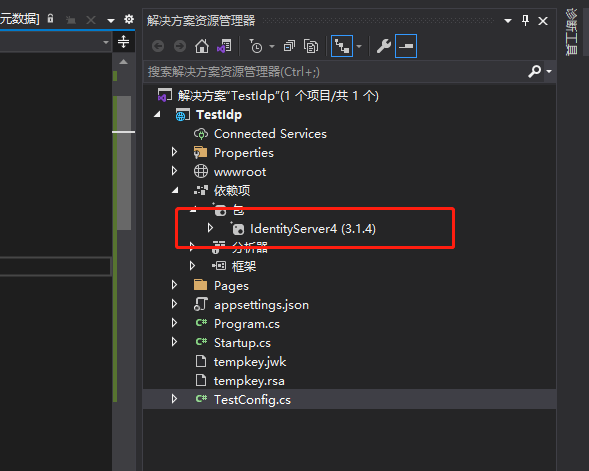
正常来说,商业业务,Api资源、Client客户端、Identity资源、User等数据存储在数据库,token可以存储在数据库也可以存储到redis,这里为了入门演示,使用内存模式,快速搭建。
定义一个类,创建API资源,客户端client,我们这里只使用客户端模式授权,篇幅问题,其他授权方式就不一一写了,基本都差不多
public class TestConfig
{
/// <summary>
/// Api资源
/// </summary>
/// <returns></returns>
public static IEnumerable<ApiResource> GetApiResources()
{
return new List<ApiResource>
{
new ApiResource(){
Name = "myapi",
ApiSecrets= new List<Secret>(){
new Secret(){
Description = "secret",
Value = "secret".Sha256()
}
},
Scopes = new List<Scope>(){
new Scope(){
Name = "apim"
}
}
},
};
}
/// <summary>
/// client
/// </summary>
/// <returns></returns>
public static IEnumerable<Client> GetClients()
{
return new List<Client>
{
new Client()
{
ClientId="client",//定义客户端ID
//AllowedGrantTypes = new List<string>()
//{
// GrantTypes.ResourceOwnerPassword.FirstOrDefault(),
// GrantType.ClientCredentials,
// GrantType.Hybrid
//},
//必须是单个指定授权类型,可能是内存模式问题。
AllowedGrantTypes = GrantTypes.ClientCredentials,
// 用于认证的密码
ClientSecrets =
{
new Secret("secret".Sha256())
},
AllowedScopes= {"apim"},
AccessTokenLifetime = 360000000
},
};
}
public static List<TestUser> GetTestUsers()
{
return new List<TestUser>
{
new TestUser()
{
SubjectId = "1",
Username = "test",
Password = "123456"
}
};
}
}
在启动类注入
public void ConfigureServices(IServiceCollection services)
{
services.AddRazorPages();
#region 内存方式
services.AddIdentityServer()
.AddDeveloperSigningCredential()//添加证书加密方式,执行该方法,会先判断tempkey.rsa证书文件是否存在,如果不存在的话,就创建一个新的tempkey.rsa证书文件,如果存在的话,就使用此证书文件。
.AddInMemoryApiResources(TestConfig.GetApiResources())//把受保护的Api资源添加到内存中
.AddInMemoryClients(TestConfig.GetClients())//客户端配置添加到内存中
.AddTestUsers(TestConfig.GetTestUsers())//测试的用户添加进来
.AddDeveloperSigningCredential();
#endregion
}
public void Configure(IApplicationBuilder app, IWebHostEnvironment env)
{
if (env.IsDevelopment())
{
app.UseDeveloperExceptionPage();
}
else
{
app.UseExceptionHandler("/Error");
}
app.UseStaticFiles();
app.UseRouting();
//添加中间件
//这个必须在UseRouting和UseEndpoints中间。如果IdentityServer服务端和API端要写在一起,
//那么这个必须在UseAuthorization和UseAuthentication的上面。
app.UseIdentityServer();
app.UseAuthorization();
app.UseEndpoints(endpoints =>
{
endpoints.MapRazorPages();
});
}
然后启动服务,使用postman访问identity server 4默认的endpoint地址发现文档:
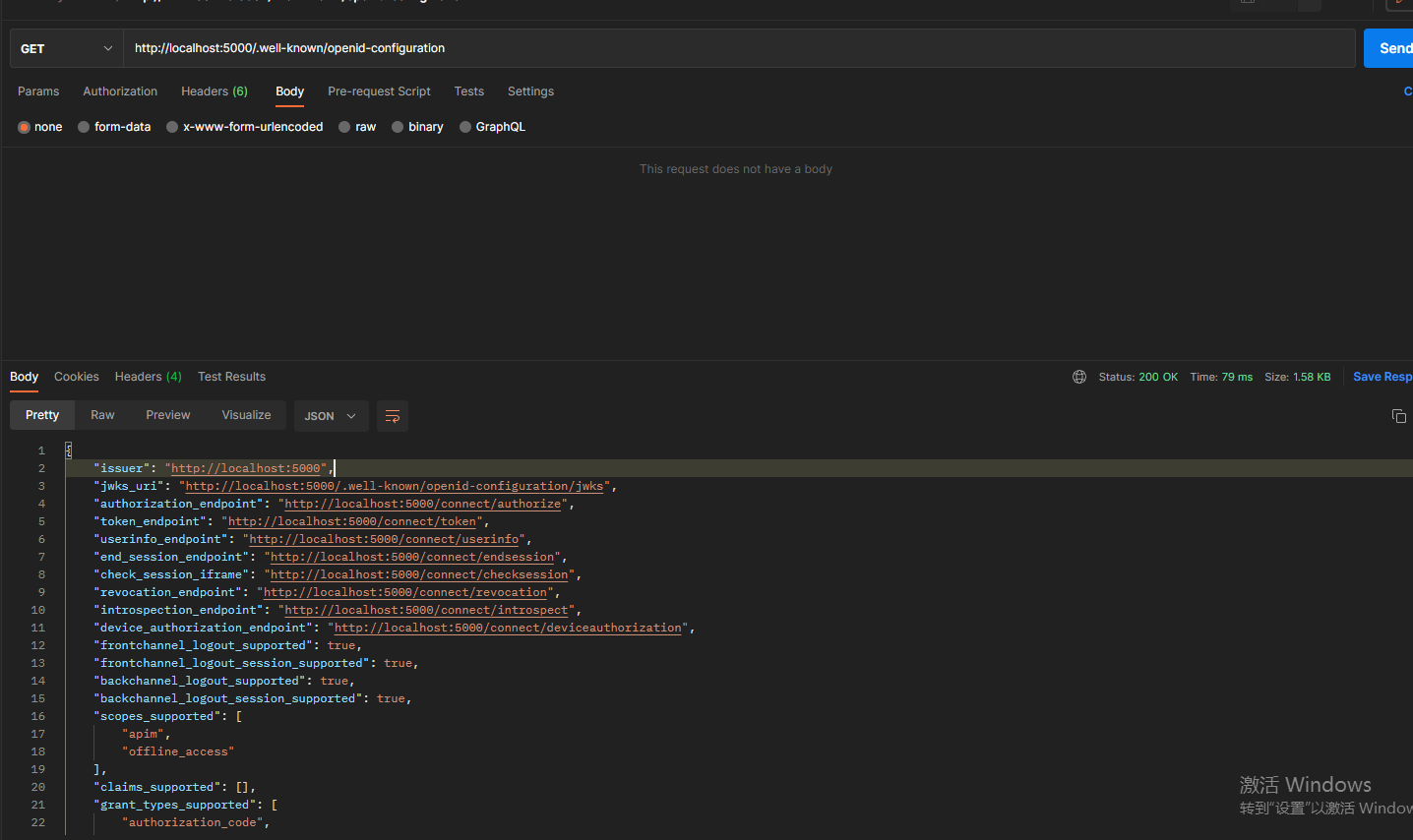
使用identityServer4的发现文档中的token_endpoint获取token
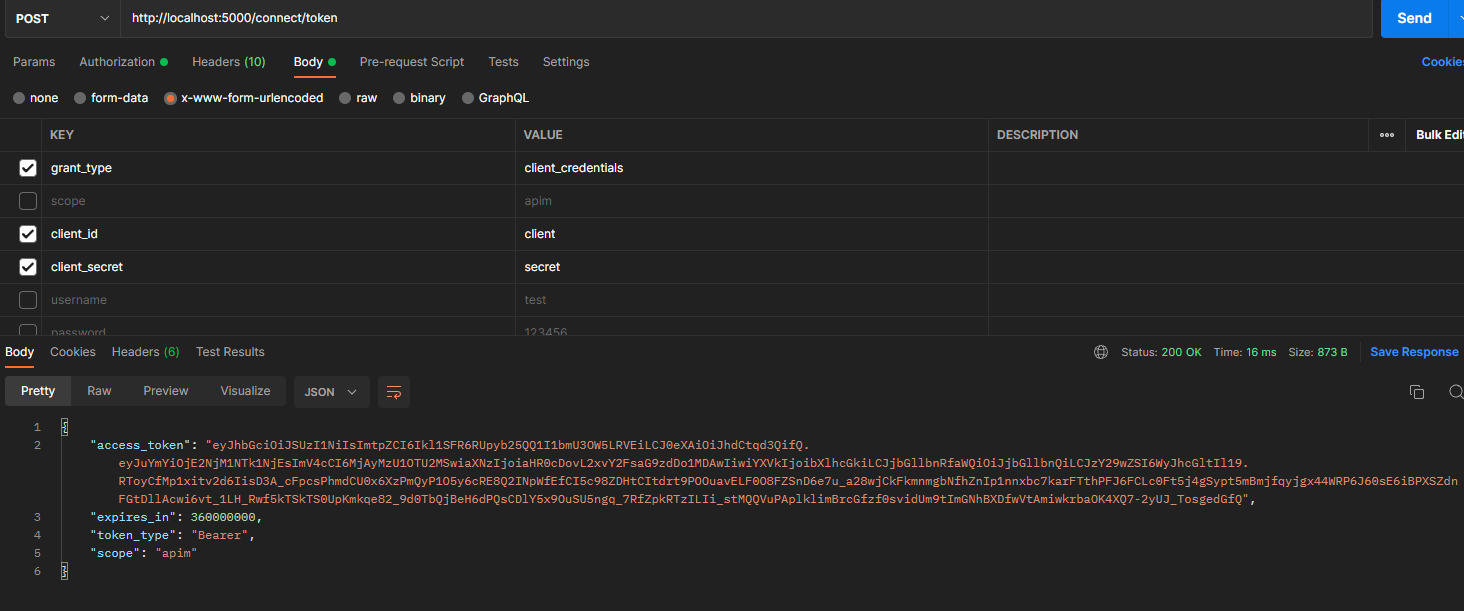
token已经获取了,可以使用发现文档里的introspection_endpoint来验证token

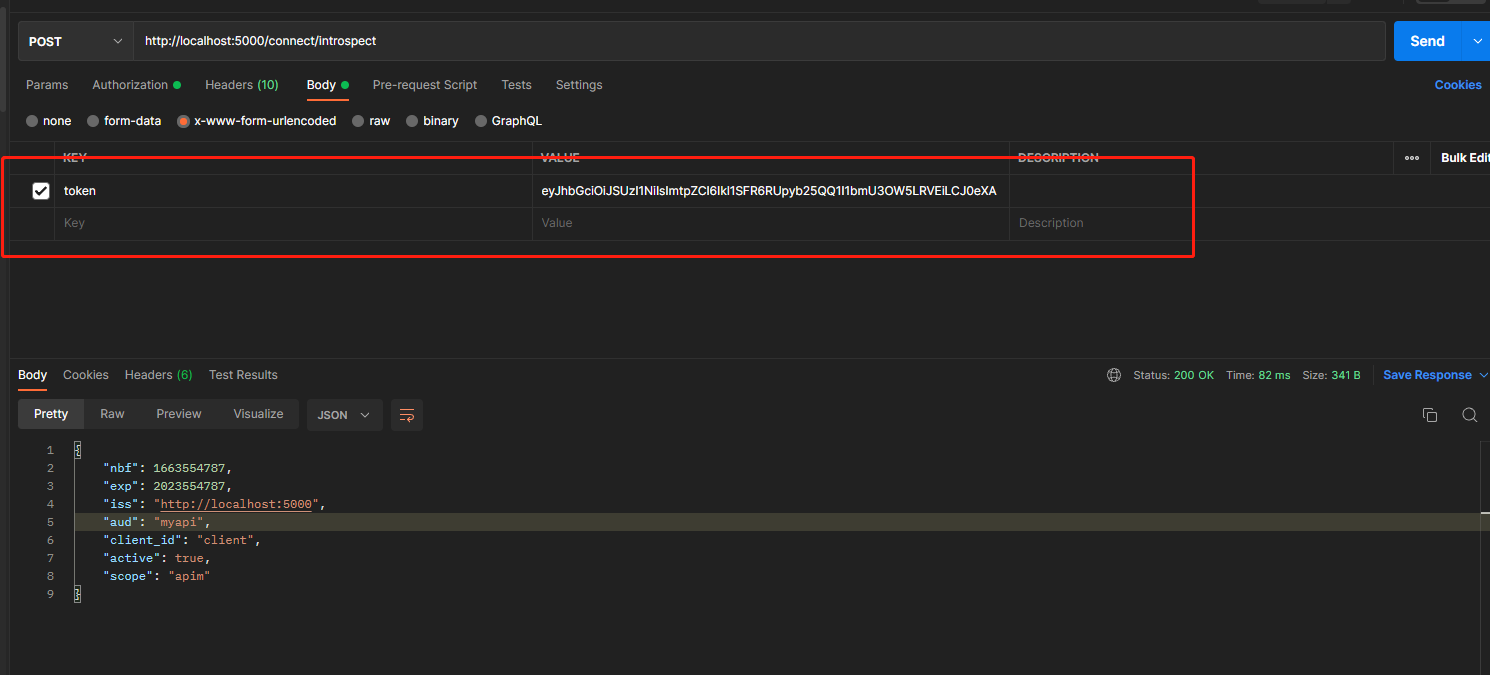
上图可见,我们已经为client客户端,创建了一个拥有访问scope为apim权限的token
接下来,创建一个受保护的api服务,同样创建一个.net core 3.1服务,并nuget包安装Microsoft.AspNetCore.Authentication.JwtBearer,选择3.14版本,根据.net core版本来
在启动类中,配置认证和授权DI,和添加认证授权中间件:
public class Startup
{
// This method gets called by the runtime. Use this method to add services to the container.
// For more information on how to configure your application, visit https://go.microsoft.com/fwlink/?LinkID=398940
readonly string MyAllowSpecificOrigins = "_myAllowSpecificOrigins";
public void ConfigureServices(IServiceCollection services)
{
//配置认证
services.AddAuthentication("Bearer")
.AddJwtBearer(options =>
{
options.Authority = "http://localhost:5000";//刚才启动的授权认证服务
options.RequireHttpsMetadata = false;
options.TokenValidationParameters = new TokenValidationParameters //不验证jwt的aud信息
{
ValidateAudience = false
};
});
// 配置授权策略
services.AddAuthorization(options =>
{
//定义授权策略,这个名字可以随便起
options.AddPolicy("ApiScope", policy =>
{
policy.RequireAuthenticatedUser();
//
policy.RequireClaim("scope", "apim");//策略需要scope有apim
});
options.AddPolicy("ApiScope2", policy =>
{
policy.RequireAuthenticatedUser();
//
policy.RequireClaim("scope", "apim2");
});
});
services.AddSingleton<IHttpContextAccessor, HttpContextAccessor>();
services
.AddCors(options =>
{
options.AddPolicy(MyAllowSpecificOrigins,
builder => builder.AllowAnyOrigin()
.WithMethods("GET", "POST", "HEAD", "PUT", "DELETE", "OPTIONS")
);
}).AddMvc();
services.AddControllers();
}
// This method gets called by the runtime. Use this method to configure the HTTP request pipeline.
public void Configure(IApplicationBuilder app, IWebHostEnvironment env)
{
if (env.IsDevelopment())
{
app.UseDeveloperExceptionPage();
}
app.Use((context, next) =>
{
context.Request.EnableBuffering();
return next();
});
app.UseRouting();
//跨域设置
app.UseCors(MyAllowSpecificOrigins);
//身份验证中间件 (身份验证必须在授权的前面)
app.UseAuthentication();
//授权验证中间件
app.UseAuthorization();
app.UseEndpoints(endpoints =>
{
endpoints.MapControllers();
});
app.UseEndpoints(endpoints =>
{
endpoints.MapGet("/", async context =>
{
await context.Response.WriteAsync("Hello World!");
});
});
}
}
写2个接口
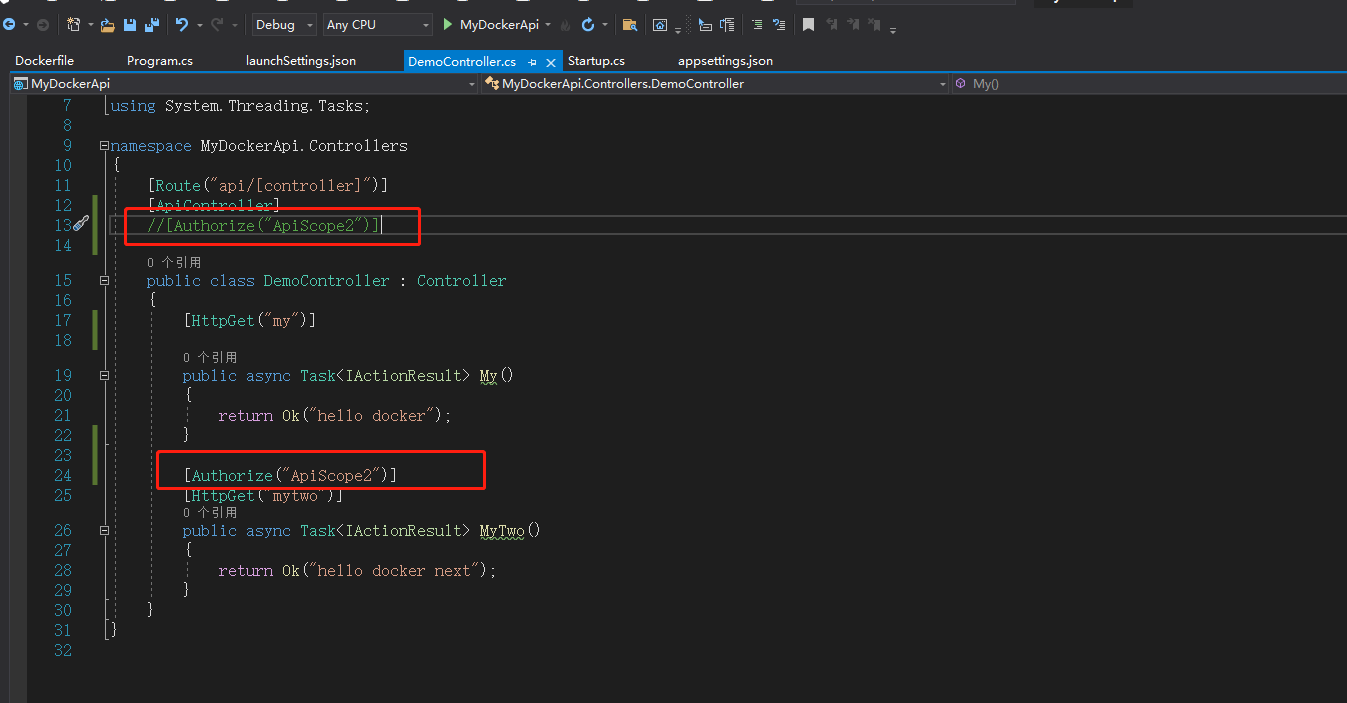
注意,Authorize标签可生效于类或者方法上,,根据不同的授权策略来合理安排需要保护的资源。最后,可以用刚才的token来访问这个API,,如果token错误会401,如果根据授权策略的不同,比如mytwo接口受到apiScope2策略保护,apiScope2策略需要apim2这个scope权限,因为刚才我们获取的token只包含apim这个scope权限,所以访问会返回403权限不足,大家可以去试试,我试过了就不贴图。

至此demo结束,大家可以去试试其他模式的获取token方式
3.IdentityServer4的数据存储
商业级项目,授权资源是需要持久化存储的,官方已经提供了基于ef core的来维护我们授权资源和token的管理模型、上下文、仓储接口等,具体我就不写了,推荐参考这篇文章.net core 3.1 Identity Server4 (EntityFramework Core 配置) - 尘叶心繁的专栏 - TNBLOG。下面贴几张基于Identity Server4 EFCore包管理的APIResource、Client、Identity资源、Token的相关代码简介
services.AddIdentityServer() .AddConfigurationStore(options => //注入idenity相关资源上下文 { options.ResolveDbContextOptions = (provider, builder) => { builder.UseSqlServer(Configuration.GetSection("Database:ConnectString").Value, sql => sql.MigrationsAssembly(migrationsAssembly)); }; }) .AddOperationalStore(options => //注入Token管理上下文 { options.ConfigureDbContext = builder => builder.UseSqlServer(Configuration.GetSection("Database:ConnectString").Value, sql => sql.MigrationsAssembly(migrationsAssembly)); options.EnableTokenCleanup = true; options.TokenCleanupInterval = 3600; }) .AddDeveloperSigningCredential();
private ConfigurationDbContext _dbContext; private PersistedGrantDbContext _grantdbContext; //这个就是identity资源上下文 private IOptions<IdentityOption> _identityOption; //这个就是token上下文 private IMediator _mediator; public ClientManager(ConfigurationDbContext dbContext, IOptions<IdentityOption> identityOption, PersistedGrantDbContext grantdbContext, IMediator mediator) { _dbContext = dbContext; _identityOption = identityOption; _grantdbContext = grantdbContext; _mediator = mediator; }
下面是部分Client客户端管理代码

public async Task<Client> CreateClient(ClientEntity clientEntity) { if (_dbContext.Clients.Any(m => m.ClientName == clientEntity.ClientName)) throw new Exception("clientName Duplicate"); if (_dbContext.Clients.Any(m => m.ClientId == clientEntity.ClientId)) throw new Exception("clientId Duplicate"); IdentityServer4.EntityFramework.Entities.Client client = new IdentityServer4.EntityFramework.Entities.Client() { ClientId = clientEntity.ClientId, ClientSecrets = new List<IdentityServer4.EntityFramework.Entities.ClientSecret>() { new IdentityServer4.EntityFramework.Entities.ClientSecret(){ Value=clientEntity.Sha256Secret, Description=clientEntity.Secret } }, ClientName = clientEntity.ClientName, // ClientUri = clientEntity.ClientUri, Description = clientEntity.Description, AccessTokenType = 1, RequireConsent = clientEntity.RequireConsent, AccessTokenLifetime = clientEntity.AccessTokenLifetime, AllowOfflineAccess = true, RedirectUris = new List<IdentityServer4.EntityFramework.Entities.ClientRedirectUri>(), PostLogoutRedirectUris = new List<IdentityServer4.EntityFramework.Entities.ClientPostLogoutRedirectUri>(), AllowedGrantTypes = new List<IdentityServer4.EntityFramework.Entities.ClientGrantType>(), Claims = new List<IdentityServer4.EntityFramework.Entities.ClientClaim>() }; if (clientEntity.RedirectUris.Count > 0) { foreach (var url in clientEntity.RedirectUris) { client.RedirectUris.Add(new IdentityServer4.EntityFramework.Entities.ClientRedirectUri() { RedirectUri = url }); } } if (clientEntity.PostLogoutRedirectUris.Count > 0) { foreach (var url in clientEntity.PostLogoutRedirectUris) { client.PostLogoutRedirectUris.Add(new IdentityServer4.EntityFramework.Entities.ClientPostLogoutRedirectUri() { PostLogoutRedirectUri = url }); } } //平台默认开放这三个类型 var typeList = new List<string>() { "hybrid", "client_credentials", "delegation" }; typeList.ForEach(type => { client.AllowedGrantTypes.Add(new IdentityServer4.EntityFramework.Entities.ClientGrantType() { GrantType = type }); }); var res = await _dbContext.Clients.AddAsync(client); await _dbContext.SaveChangesAsync(); return res.Entity; } public async Task<Client> UpdateClient(ClientEntity clientEntity) { if (_dbContext.Clients.Any(m => m.ClientName == clientEntity.ClientName && m.Id != clientEntity.Id)) throw new Exception("clientName Duplicate"); var client = await _dbContext.Clients .Include(x => x.AllowedGrantTypes) .Include(x => x.RedirectUris) .Include(x => x.PostLogoutRedirectUris) .Include(x => x.AllowedScopes) .Include(x => x.ClientSecrets) .Include(x => x.Claims) .Include(x => x.IdentityProviderRestrictions) .Include(x => x.AllowedCorsOrigins) .Include(x => x.Properties) .FirstOrDefaultAsync(x => x.Id == clientEntity.Id); if (client == null) throw new Exception("Client Not Exists!"); client.ClientName = clientEntity.ClientName; client.Description = clientEntity.Description; client.AccessTokenLifetime = clientEntity.AccessTokenLifetime; client.RequireConsent = clientEntity.RequireConsent; client.Enabled = clientEntity.Enabled; client.RedirectUris = new List<IdentityServer4.EntityFramework.Entities.ClientRedirectUri>(); client.PostLogoutRedirectUris = new List<IdentityServer4.EntityFramework.Entities.ClientPostLogoutRedirectUri>(); client.AllowedScopes = new List<IdentityServer4.EntityFramework.Entities.ClientScope>(); client.AllowedGrantTypes = new List<IdentityServer4.EntityFramework.Entities.ClientGrantType>(); if (clientEntity.RedirectUris.Count > 0) { foreach (var url in clientEntity.RedirectUris) { client.RedirectUris.Add(new IdentityServer4.EntityFramework.Entities.ClientRedirectUri { RedirectUri = url }); } } if (clientEntity.PostLogoutRedirectUris.Count > 0) { foreach (var url in clientEntity.PostLogoutRedirectUris) { client.PostLogoutRedirectUris.Add(new IdentityServer4.EntityFramework.Entities.ClientPostLogoutRedirectUri { PostLogoutRedirectUri = url }); } } foreach (string scope in clientEntity.AllowedScopes) { client.AllowedScopes.Add(new IdentityServer4.EntityFramework.Entities.ClientScope { Scope = scope }); } foreach (string key in clientEntity.AllowedGrantTypes) { client.AllowedGrantTypes.Add(new IdentityServer4.EntityFramework.Entities.ClientGrantType { GrantType = key }); } var res = _dbContext.Clients.Update(client); await _dbContext.SaveChangesAsync(); return res.Entity; }
下面以部分token管理代码

public async Task<string> GenerateToken(int id, string nickName, string projectGroup, string contact, string useReason) { var client = await _dbContext.Clients .Include(x => x.AllowedGrantTypes) .Include(x => x.RedirectUris) .Include(x => x.PostLogoutRedirectUris) .Include(x => x.AllowedScopes) .Include(x => x.ClientSecrets) .Include(x => x.Claims) .Include(x => x.IdentityProviderRestrictions) .Include(x => x.AllowedCorsOrigins) .Include(x => x.Properties) .FirstOrDefaultAsync(x => x.Id == id); if (client == null) throw new Exception("Client Not Exists!"); //初始化连接IdentityServer客户端,这也是人家封装好的http请求 var discoveryClient = new DiscoveryClient(_identityOption.Value.Host) { Policy = new DiscoveryPolicy { RequireHttps = _identityOption.Value.Https, ValidateIssuerName = false } }; //获取endpint var discoveryResponse = await discoveryClient.GetAsync(); //连接获取token那个endpoint var tokenClient = new TokenClient(discoveryResponse.TokenEndpoint, client.ClientId, client.ClientSecrets.FirstOrDefault().Description); #region 计算当前client的拥有的API资源SCOPE var allScopes = client.AllowedScopes.Select(p => p.Scope).ToList(); var apiResourceScopes = new List<string>(); _dbContext.ApiResources.Include("Scopes").ToList().ForEach(api => { if (api.Scopes.Count > 0) apiResourceScopes.AddRange(api.Scopes.Select(p => p.Name).ToList()); }); var inScopes = apiResourceScopes.Intersect(allScopes); #endregion var scope = string.Join(" ", inScopes); //请求生成客户端模式的token var tokenResponse = await tokenClient.RequestCustomGrantAsync("client_credentials", scope); if (tokenResponse.IsError) { throw new Exception(tokenResponse.Error); } else { //发送事件 var _key = string.Format("{0}:reference_token", tokenResponse.AccessToken).ToSha256(); var tokenEntity = new TokenEntity(_key, nickName, projectGroup, contact, useReason, client.ClientId, tokenResponse.AccessToken); await _mediator.Publish<GenerateTokenEvent>(new GenerateTokenEvent(tokenEntity)); return tokenResponse.AccessToken; } }
下面还有一段关于修改token过期时间的代码

public async Task<bool> AddExpiration(string token, DateTime date) { if (!_dbContext.TokenEntities.Any(p => p.Token == token)) throw new Exception("manage token not exsits"); //这个key是经过一定格式后进行sha256加密后,作为数据库表PersistedGrants一个唯一标识 var _key = string.Format("{0}:reference_token", token).ToSha256(); var persistedGrant = _grantdbContext.PersistedGrants.FirstOrDefault(p => p.Key == _key); if (persistedGrant == null) throw new Exception("token不存在或者TOKEN已过期"); var data = JObject.Parse(persistedGrant.Data); var creation = data.Value<DateTime>("CreationTime"); var lifetime = data.Value<int>("Lifetime"); data["Lifetime"] = (int)((date - creation).TotalSeconds); persistedGrant.Expiration = date; persistedGrant.Data = data.ToString(Newtonsoft.Json.Formatting.None); _grantdbContext.PersistedGrants.Update(persistedGrant); await _grantdbContext.SaveChangesAsync(); return true; }
再来一段自定义授权模式代码

public class DelegationGrantValidator : IExtensionGrantValidator//需要继承一下类型验证扩展接口 { private readonly ITokenValidator _validator;//identity框架已实现的token验证服务,直接注入使用 public DelegationGrantValidator(ITokenValidator validator) { _validator = validator; } public string GrantType => "delegation";//自定义的授权类型,我这实现的是一个token交换token的类型 public async Task ValidateAsync(ExtensionGrantValidationContext context) { var userToken = context.Request.Raw.Get("token");//获取被交换token if (string.IsNullOrEmpty(userToken)) { context.Result = new GrantValidationResult(TokenRequestErrors.InvalidGrant); return; } var result = await _validator.ValidateAccessTokenAsync(userToken);//直接使用人家实现好的token验证服务验证传来的token if (result.IsError) { context.Result = new GrantValidationResult(TokenRequestErrors.InvalidGrant); return; } //声明获取用户,如果有用户,说明要换取用户token var sub = result.Claims.FirstOrDefault(c => c.Type == "sub")?.Value; if (sub != null) { context.Result = new GrantValidationResult(sub, GrantType);//换取用户token, return; } // 声明中获取客户端ID,如果有clientId,说明换取客户端token var client_id = result.Claims.FirstOrDefault(c => c.Type == "client_id")?.Value; if (client_id != null) { //context.Result = new GrantValidationResult(client_id, GrantType); context.Result = new GrantValidationResult();//换取客户端token return; } context.Result = new GrantValidationResult(TokenRequestErrors.InvalidRequest); } } builder.AddExtensionGrantValidator<DelegationGrantValidator>();注入DI。
IdentityServer4还可以扩展endpoint,但是扩展完后,在发现文档不显示,但是可以作为http使用,以下代码截图供参考
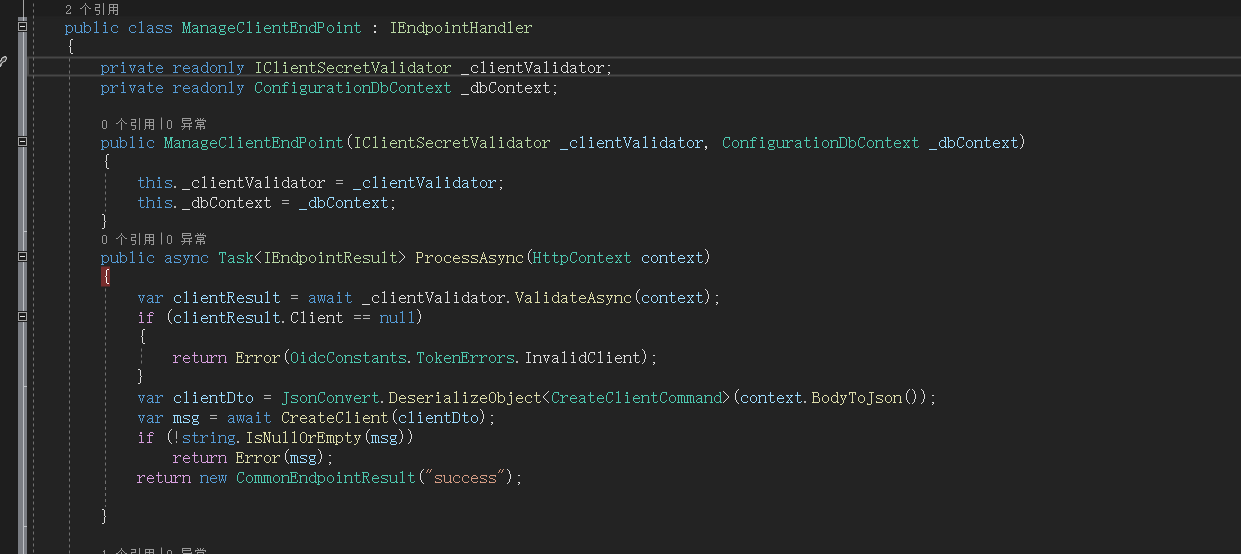
4.结尾
identityServer4要写的东西实在太多,整体的把握理解还是有一定的复杂性的,我之前公司一个pass平台项目,是基于认证中心,其他业务系统实现快速集成,我当时负责的就是授权资源、token管理,还有对IDP的授权类型、endpoint一些扩展,现在总结成博客,写的不是很细,希望对后来者带来一些帮助和参考意义。



